An Investigation of the Mechanical and Physical Characteristics of Cement Paste Incorporating Different Air Entraining Agents using X-ray Micro-Computed Tomography
Abstract
1. Introduction
2. Preparation of Specimens
2.1. Materials
2.2. Mix Proportions and Specimen Preparation
3. Measurements of Characteristic Properties
3.1. Material Properties
3.1.1. Material Density
3.1.2. Compressive Strength
3.1.3. Thermal Properties
3.1.4. Effective Water Porosity
3.1.5. Water Absorption
3.2. Microstructure Evaluation Using X-Ray Micro-Computed Tomography (Micro-CT)
4. Results and Discussions
4.1. Material Properties of the Specimens
4.1.1. Density
4.1.2. Compressive Strength
4.1.3. Effective Water Porosity
4.1.4. Water Absorption
4.1.5. Thermal Conductivity
4.2. Pore Characteristics Using X-Ray CT
5. Conclusions
- An addition of aluminum powder increases air void contents more than other air-induced materials even with lower dosage. The addition of 0.5 wt.% of aluminum powder significantly reduces dry density, while higher dosages have negligible additional effects. The dry density of the specimens with air entraining agent and hollow microspheres are similar and reduced gradually with increasing the dosages.
- Dry density and compressive strength of aluminum powder pastes are much lower than both air entraining agent and hollow microspheres.
- Thermal conductivity is related directly to material density as reflected by the experimental results. Aluminum powder mixes had the lowest thermal conductivity, as compared to air entraining agent and hollow microspheres, with aluminum powder being the most effective for the purposes of insulation.
- Mixes with hollow microspheres showed lower thermal conductivity than mixes with air entraining agent due to different in density as well as pore size distribution.
- Among the used air entraining additives, the use of hollow microspheres is the most beneficial to achieve higher compressive strength. In contrast, aluminum powder can produce highly porous and large pores, as according to the micro-CT measurements. In particular, the use of aluminum powder can generate anisotropic pore clusters, which can cause a reduction in mechanical properties, while improving insulation.
Author Contributions
Funding
Acknowledgments
Conflicts of Interest
References
- IEA. CO2 Emissions from Fuel Combustion Highlights; International Energy Agency: Paris, France, 2016. [Google Scholar]
- Tyagi, V.V.; Pandey, A.K.; Buddhi, D.; Kothari, R. Thermal performance assessment of encapsulated PCM based thermal management system to reduce peak energy demand in buildings. Energy Build. 2016, 117, 44–52. [Google Scholar] [CrossRef]
- Foraboschi, P. Effectiveness of novel methods to increase the FRP-masonry bond capacity. Comp. Part B Eng. 2016, 107, 214–232. [Google Scholar] [CrossRef]
- Chung, S.-Y.; Stephan, D.; Abd Elrahman, M.; Han, T.-S. Effects of anisotropic voids on thermal properties of insulating media investigated using 3D printed samples. Constr. Build. Mater. 2016, 111, 529–542. [Google Scholar] [CrossRef]
- Chung, S.-Y.; Abd Elrahman, M.; Stephan, D.; Kamm, P.H. The influence of different concrete additions on the properties of lightweight concrete evaluated using experimental and numerical approaches. Constr. Build. Mater. 2018, 189, 314–322. [Google Scholar] [CrossRef]
- Garbalińska, H.; Strzałkowski, J. Thermal and strength properties of lightweight concretes with variable porosity structures. J. Mater. Civ. Eng. 2018, 30, 04018326. [Google Scholar] [CrossRef]
- Sadowski, Ł.; Popek, M.; Czarnecki, S.; Mathia, T.G. Morphogenesis in solidification phases of lightweight concrete surface at early ages. Constr. Build. Mater. 2017, 148, 96–103. [Google Scholar] [CrossRef]
- Kurpinska, M.; Kułak, L. Predicting Performance of Lightweight Concrete with Granulated Expanded Glass and Ash Aggregate by Means of Using Artificial Neural Networks. Materials 2019, 12, 2002. [Google Scholar] [CrossRef]
- Foraboschi, P. Masonry does not limit itself to only one structural material: Interlocked masonry versus cohesive masonry. J. Build. Eng. 2019, 26, 100831. [Google Scholar] [CrossRef]
- Dorey, R.; Yeomans, J.; Smith, P. Effect of pore clustering on the mechanical properties of ceramics. J. Eur. Ceram. Soc. 2002, 22, 403–409. [Google Scholar] [CrossRef]
- Amran, Y.H.; Farzadnia, N.; Ali, A.A. Properties and applications of foamed concrete; a review. Constr. Build. Mater. 2015, 101, 990–1005. [Google Scholar] [CrossRef]
- Jaing, J.; Lu, Z.; Niu, Y.; Li, J.; Zhang, Y. Study on the preparation and properties of high-porosity foamed concretes based on ordinary portland cement. Mater. Des. 2016, 92, 949–959. [Google Scholar] [CrossRef]
- Chung, S.-Y.; Lehmann, C.; Abd Elrahman, M.; Stephan, D. Pore characteristics and their effects on the material properties of foamed concrete evaluated using micro-CT images and numerical approaches. Appl. Sci. 2017, 7, 550. [Google Scholar] [CrossRef]
- Foraboschi, P. Bending load-carrying capacity of reinforced concrete beams subjected to premature failure. Materials 2019, 12, 3085. [Google Scholar] [CrossRef] [PubMed]
- Foraboschi, P. Structural layout that takes full advantage of the capabilities and opportunities afforded by two-way RC floors, coupled with the selection of the best technique, to avoid serviceability failures. Eng. Fail. Anal. 2016, 70, 387–418. [Google Scholar] [CrossRef]
- Abd Elrahman, M.; Chung, S.-Y.; Sikora, P.; Rucinska, T.; Stephan, D. Influence of nanosilica on mechanical properties, sorptivity, and microstructure of lightweight concrete. Materials 2019, 12, 3078. [Google Scholar] [CrossRef] [PubMed]
- Chung, S.-Y.; Kim, J.-S.; Stephan, D.; Han, T.-S. Overview of the use of micro-computed tomography (micro-CT) to investigate the relation between the material characteristics and properties of cement-based materials. Constr. Build. Mater. 2019, 229, 116843. [Google Scholar] [CrossRef]
- Vesova, L.M. Disperse reinforcing Role in Producing Non-autoclaved Cellular Foam Concrete. Procedia Eng. 2016, 150, 1587–1590. [Google Scholar] [CrossRef]
- Esmaily, H.; Nuranian, H. Non-autoclaved high strength cellular concrete from alkali activated slag. Constr. Build. Mater. 2012, 266, 200–206. [Google Scholar] [CrossRef]
- Wang, C.-Q.; Lin, X.-Y.; Wang, D.; He, M.; Zhang, S.-L. Utilization of oil-based drilling cuttings pyrolysis residues of shale gas for the preparation of non-autoclaved aerated concrete. Constr. Build. Mater. 2018, 162, 359–368. [Google Scholar] [CrossRef]
- Cabrillac, R.; Fiorio, B.; Beaucour, A.; Dumontet, H.; Ortola, S. Experimental study of the mechanical anisotropy of aerated concretes and of the adjustment parameters of the introduced porosity. Constr. Build. Mater. 2016, 20, 286–295. [Google Scholar] [CrossRef]
- Neville, A.M. Properties of Concrete; Wiley: Chichester, UK, 2012; pp. 10–24. [Google Scholar]
- Ley, M.T.; Chancey, R.; Juenger, M.; Folliard, K. The physical and chemical characteristics of the shell of air-entrained bubbles in cement paste. Cem. Concr. Res. 2009, 39, 417–425. [Google Scholar] [CrossRef]
- Hilal, A.A.; Thom, N.H.; Dawson, A.R. On void structure and strength of foamed concrete made without/with additives. Constr. Build. Mater. 2015, 85, 157–164. [Google Scholar] [CrossRef]
- Narayanan, N.; Ramamurthy, K. Structure and properties of aerated concrete: A review. Cem. Concr. Compos. 2000, 22, 321–329. [Google Scholar] [CrossRef]
- Schackow, A.; Effting, C.; Folgueras, M.V.; Guths, S.; Mendes, G.A. Mechanical and thermal properties of lightweight concretes with vermiculite and EPS using air-entraining agent. Constr. Build. Mater. 2014, 57, 190–197. [Google Scholar] [CrossRef]
- Xie, Y.; Li, J.; Lu, Z.; Jiang, J.; Niu, Y. Preparation and properties of ultra-lightweight EPS concrete based on pre-saturated bentonite. Constr. Build. Mater. 2019, 195, 505–514. [Google Scholar] [CrossRef]
- Riyzai, S.; Kevern, J.T.; Mulheron, M.M. Super absorbent polymers (SAPs) as physical air entrainment in cement mortars. Constr. Build. Mater. 2017, 147, 669–676. [Google Scholar] [CrossRef]
- Naratha, C.; Thongsanitgarn, P.; Chaipanich, A. Thermogravimetry analysis, compressive strength and thermal conductivity tests of non-autoclaved aerated Portland cement-fly ash-silica fume concrete. J. Therm. Anal. Calorim. 2015, 122, 11–20. [Google Scholar] [CrossRef]
- Ramamurthy, K.; Narayanan, N. Factors influencing the density and compressive strength of aerated concrete. Mag. Concr. Res. 2000, 52, 163–168. [Google Scholar] [CrossRef]
- Aguilar, A.S.; Melo, J.P.; Olivares, F.H. Microstructural analysis of aerated cement pastes with fly ash, metakaolin and Sepiolite additions. Constr. Build. Mater. 2013, 47, 282–292. [Google Scholar] [CrossRef]
- Yang, L.; Yan, Y.; Hu, Z. Utilization of phosphogypsum for the preparation of non-autoclaved aerated concrete. Constr. Build. Mater. 2013, 44, 600–606. [Google Scholar] [CrossRef]
- Chen, X.; Yan, Y.; Liu, Y.; Hu, Z. Utilization of circulating fluidized bed fly ash for the preparation of foam concrete. Constr. Build. Mater. 2014, 54, 137–146. [Google Scholar] [CrossRef]
- Kearsley, E.P.; Wainwright, P.J. The effect of porosity on the strength of foamed concrete. Cem. Concr. Res. 2002, 18, 390–398. [Google Scholar] [CrossRef]
- Korat, L.; Ducman, V.; Legat, A.; Mirtic, B. Characterisation of the pore-forming process in lightweight aggregate based on silica sludge by means of X-ray micro-tomography (micro-CT) and mercury intrusion porosimetry (MIP). Cem. Concr. Res. 2013, 39, 6997–7005. [Google Scholar] [CrossRef]
- Gallucci, E.; Scrivener, K.; Groso, A.; Stampanoni, M.; Margaritondo, G. 3D experimental investigation of the microstructure of cement pastes using synchrotron X-ray microtomography. Cem. Concr. Res. 2007, 37, 360–368. [Google Scholar] [CrossRef]
- Chung, S.-Y.; Han, T.-S.; Yun, T.S.; Yeom, K.S. Evaluation of the anisotropy of the void distribution and the stiffness of lightweight aggregates using CT imaging. Constr. Build. Mater. 2013, 48, 998–1008. [Google Scholar] [CrossRef]
- Patterson, B.M.; Escobedo-Diaz, J.P.; Dennis-Koller, D.; Cerreta, E. Dimensional quantification of embedded voids or objects in three dimensions using X-ray tomograph. Microsc. Microanal. 2012, 18, 390–398. [Google Scholar] [CrossRef]
- Chung, S.-Y.; Elrahman, M.A.; Kim, J.-S.; Han, T.-S.; Stephan, D.; Sikora, P. Comparison of lightweight aggregate and foamed concrete with the same density level using image-based characterizations. Constr. Build. Mater. 2019, 211, 988–999. [Google Scholar] [CrossRef]
- Chung, S.-Y.; Abd Elrahman, M.; Stephan, D.; Kamm, P.H. Investigation of characteristics and responses of insulating cement paste specimens with Aer solids using X-ray micro-computed tomography. Constr. Build. Mater. 2016, 118, 204–215. [Google Scholar] [CrossRef]
- ISO 22007-2:2015. Plastics–Determination of Thermal Conductivity and Thermal Diffusivity–Part 2: Transient Plane Heat Source (Hot Disk) Method. Available online: https://www.iso.org/standard/61190.html (accessed on 13 December 2019).
- Abd Elrahman, M.; Hillemeier, B. Combined effect of fine fly ash and packing density on the properties of high performance concrete: An experimental approach. Constr. Build. Mater. 2014, 58, 225–233. [Google Scholar] [CrossRef]
- MATLAB Version 2018a; The MathWorks Inc.: Natick, MA, USA, 2018.
- Otsu, N. A threshold selection method from gray-level histograms. IEEE Trans. Syst. Man Cybern. 1979, 9, 62–66. [Google Scholar] [CrossRef]
- Shabbar, R.; Nedwell, P.; Wu, Z. Mechanical properties of lightweight aerated concrete with different aluminum powder content. MATEC Web of Conf. 2017, 120, 02010. [Google Scholar] [CrossRef]
- Ramaschndran, V.S. Concrete Admixtures Handbook; William Andrew: New York, NY, USA, 1996. [Google Scholar]
- Mindess, S.; Young, J.F.; Darwin, D. Concrete; Prentice Hall: New York, NY, USA, 2002. [Google Scholar]

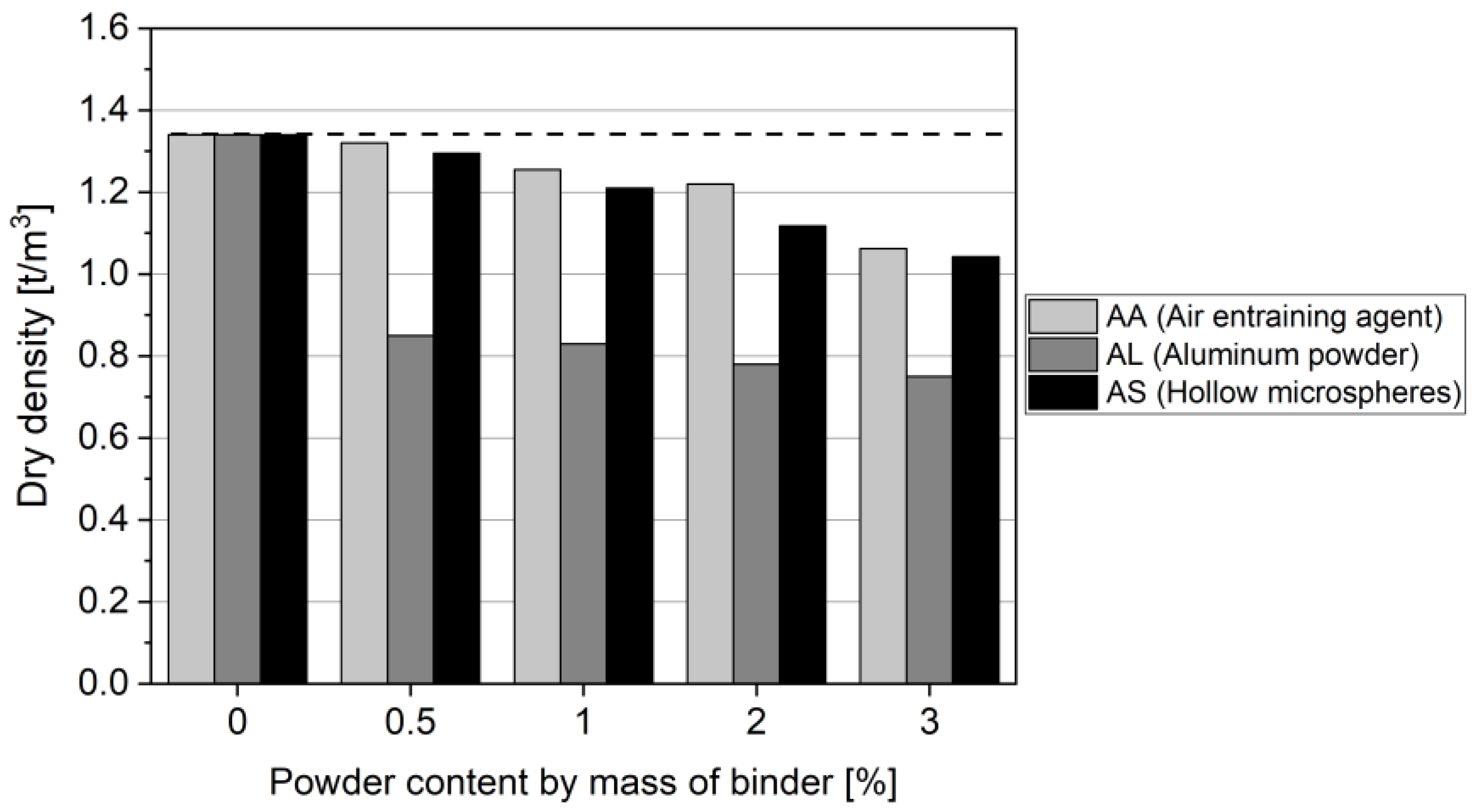
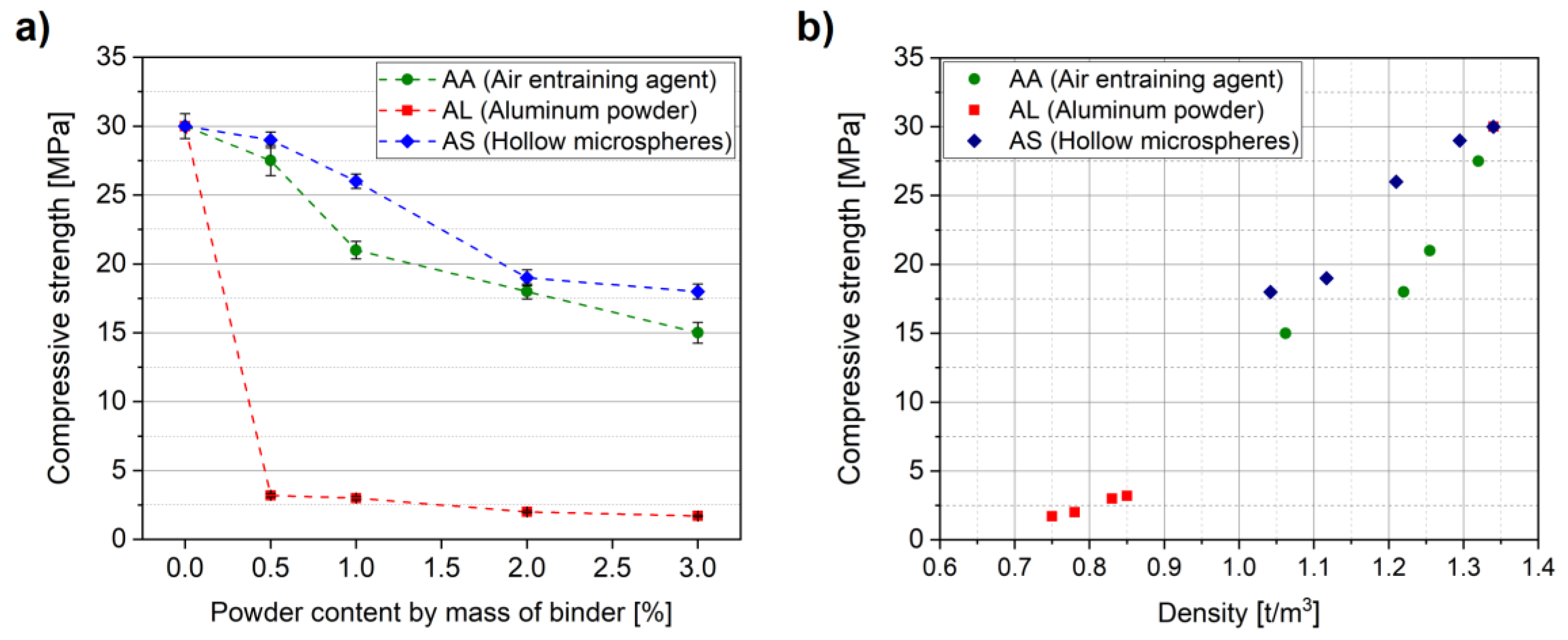
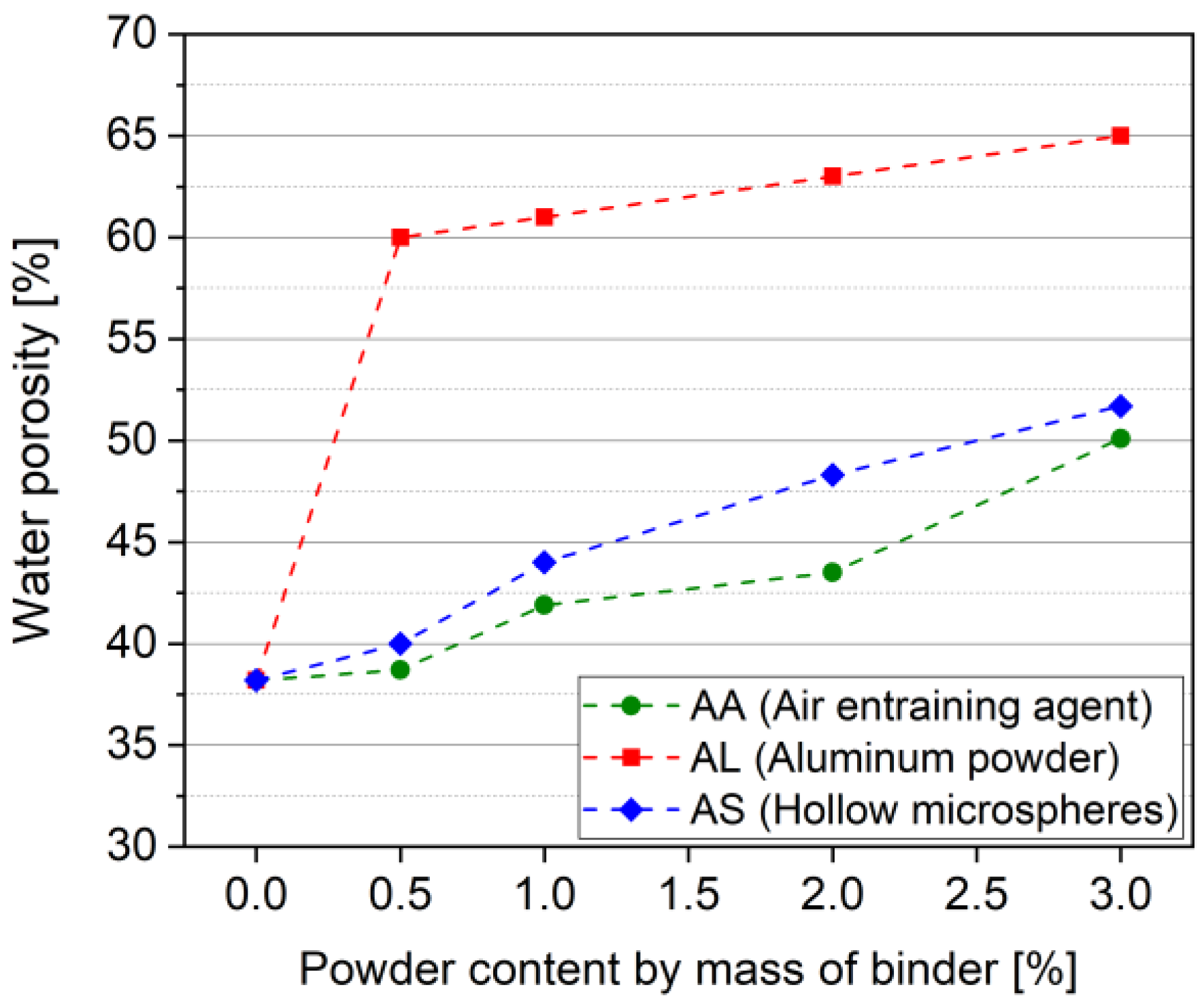
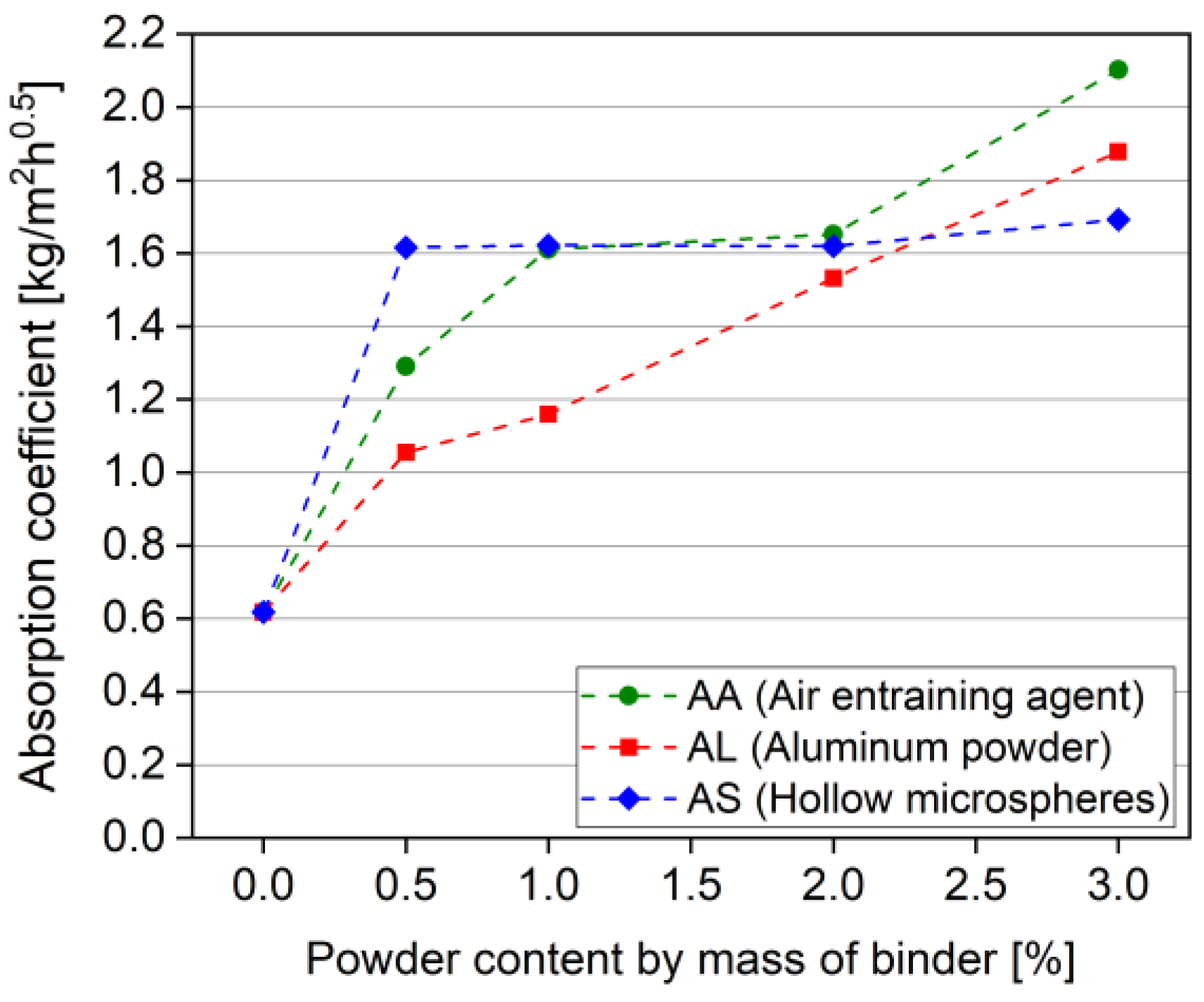
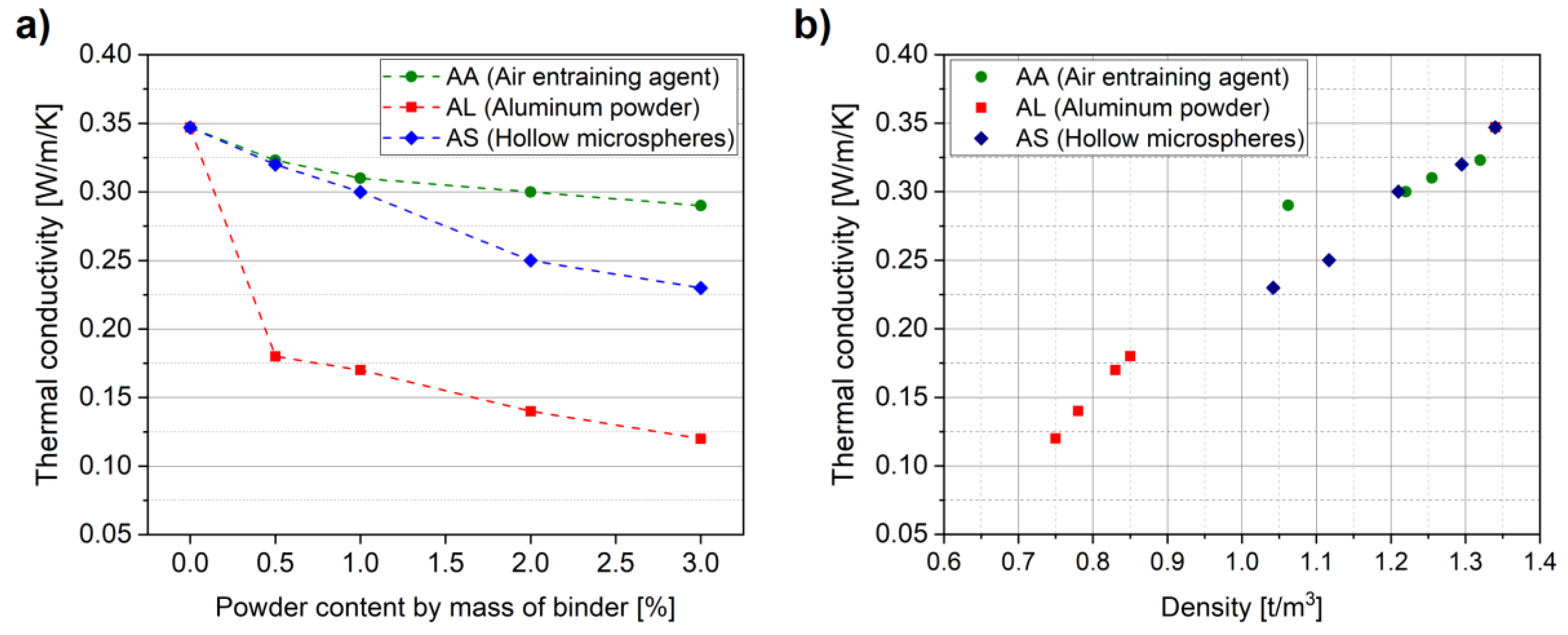
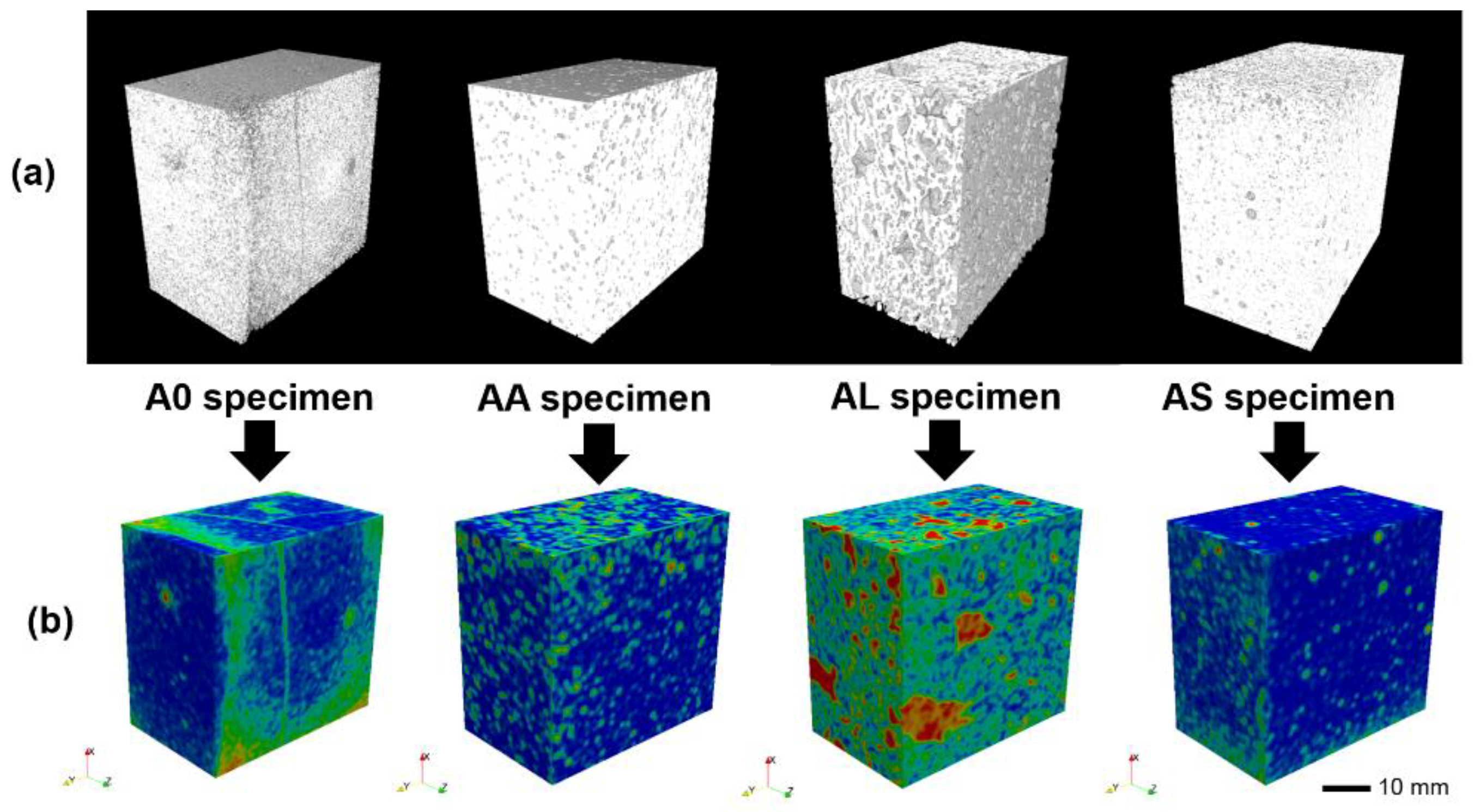
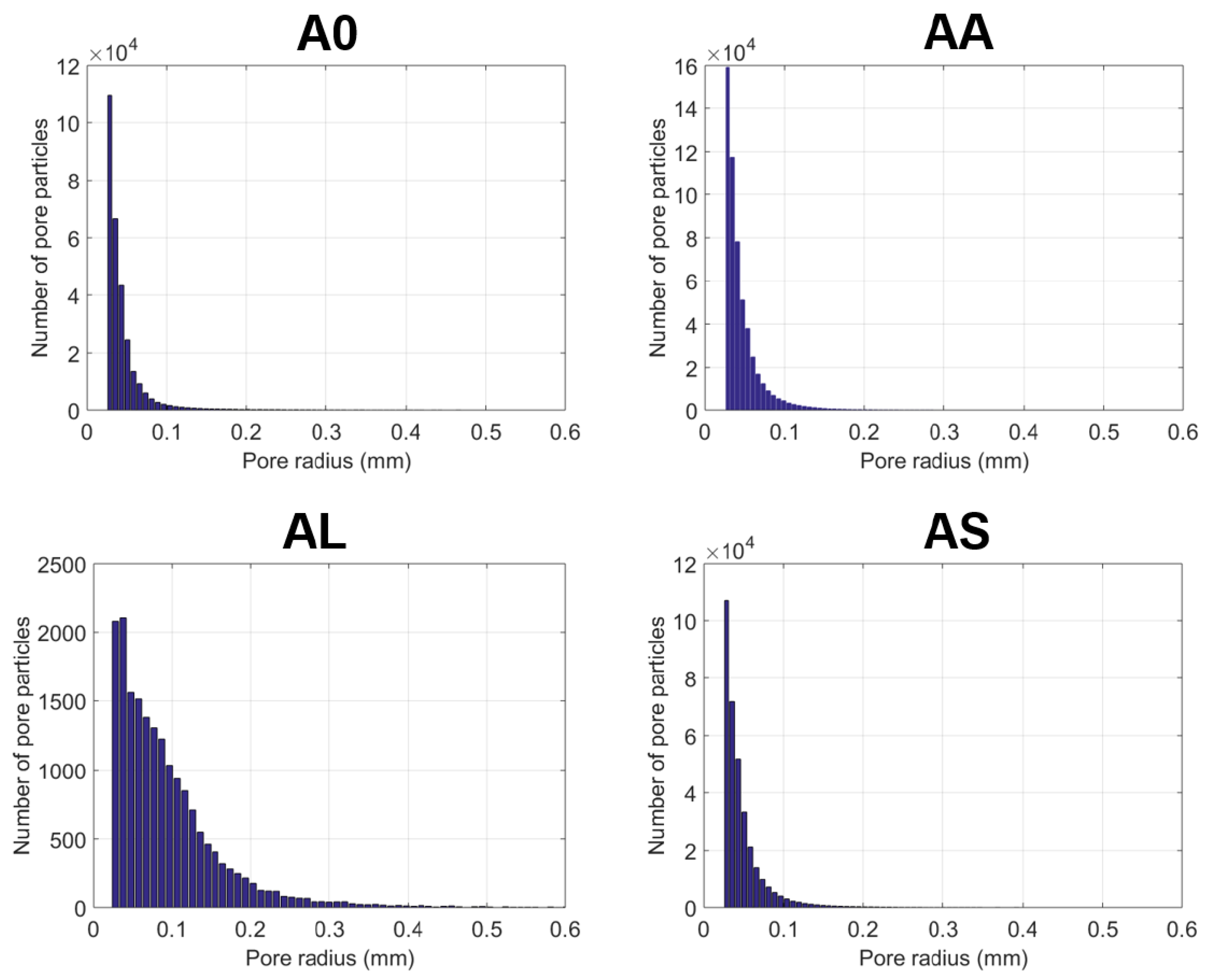
| Material | CaO | SiO2 | Al2O3 | Fe2O3 | MgO | Na2O | K2O | SO3 | Blaine Fineness [cm2/g] | Density [g/cm3] |
|---|---|---|---|---|---|---|---|---|---|---|
| CEM I 42.5 N | 65.0 | 19.9 | 4.6 | 3.1 | 1.7 | 0.3 | 0.5 | 3.0 | 3500 | 3.1 |
| Fly ash | 3.1 | 49.2 | 27.6 | 7.6 | 2.1 | 0.9 | 5.0 | 0.7 | 2877 | 2.3 |
| Mix | Cement [g] | Fly Ash [g] | w/b Ratio | Air Entraining Agent [g] | Aluminum Powder [g] | Hollow Microspheres [g] |
|---|---|---|---|---|---|---|
| A0 | 600 | 1800 | 0.5 | - | - | - |
| AA0.5 | 600 | 1800 | 0.5 | 12 | - | - |
| AA1 | 600 | 1800 | 0.5 | 24 | - | - |
| AA2 | 600 | 1800 | 0.5 | 48 | - | - |
| AA3 | 600 | 1800 | 0.5 | 72 | - | - |
| AL0.5 | 600 | 1800 | 0.5 | - | 12 | - |
| AL1 | 600 | 1800 | 0.5 | - | 24 | - |
| AL2 | 600 | 1800 | 0.5 | - | 48 | - |
| AL3 | 600 | 1800 | 0.5 | - | 72 | - |
| AS0.5 | 600 | 1800 | 0.5 | - | - | 12 |
| AS1 | 600 | 1800 | 0.5 | - | - | 24 |
| AS2 | 600 | 1800 | 0.5 | - | - | 48 |
| AS3 | 600 | 1800 | 0.5 | - | - | 72 |
© 2020 by the authors. Licensee MDPI, Basel, Switzerland. This article is an open access article distributed under the terms and conditions of the Creative Commons Attribution (CC BY) license (http://creativecommons.org/licenses/by/4.0/).
Share and Cite
Abd Elrahman, M.; El Madawy, M.E.; Chung, S.-Y.; Majer, S.; Youssf, O.; Sikora, P. An Investigation of the Mechanical and Physical Characteristics of Cement Paste Incorporating Different Air Entraining Agents using X-ray Micro-Computed Tomography. Crystals 2020, 10, 23. https://doi.org/10.3390/cryst10010023
Abd Elrahman M, El Madawy ME, Chung S-Y, Majer S, Youssf O, Sikora P. An Investigation of the Mechanical and Physical Characteristics of Cement Paste Incorporating Different Air Entraining Agents using X-ray Micro-Computed Tomography. Crystals. 2020; 10(1):23. https://doi.org/10.3390/cryst10010023
Chicago/Turabian StyleAbd Elrahman, Mohamed, Mohamed E. El Madawy, Sang-Yeop Chung, Stanisław Majer, Osama Youssf, and Pawel Sikora. 2020. "An Investigation of the Mechanical and Physical Characteristics of Cement Paste Incorporating Different Air Entraining Agents using X-ray Micro-Computed Tomography" Crystals 10, no. 1: 23. https://doi.org/10.3390/cryst10010023
APA StyleAbd Elrahman, M., El Madawy, M. E., Chung, S.-Y., Majer, S., Youssf, O., & Sikora, P. (2020). An Investigation of the Mechanical and Physical Characteristics of Cement Paste Incorporating Different Air Entraining Agents using X-ray Micro-Computed Tomography. Crystals, 10(1), 23. https://doi.org/10.3390/cryst10010023








